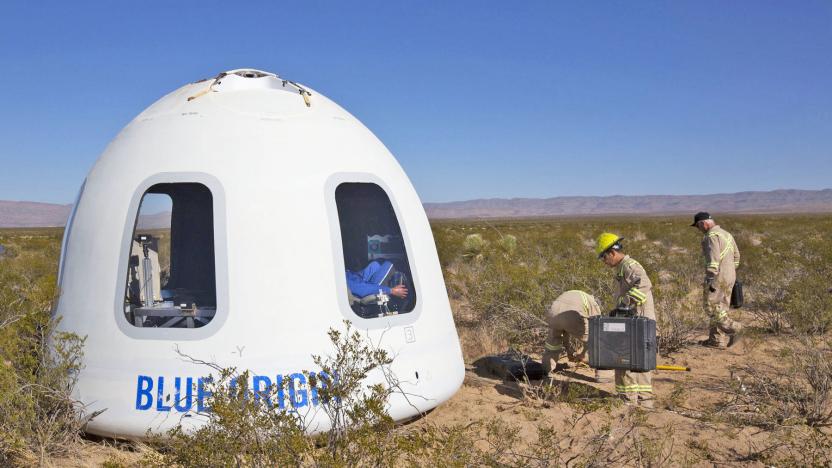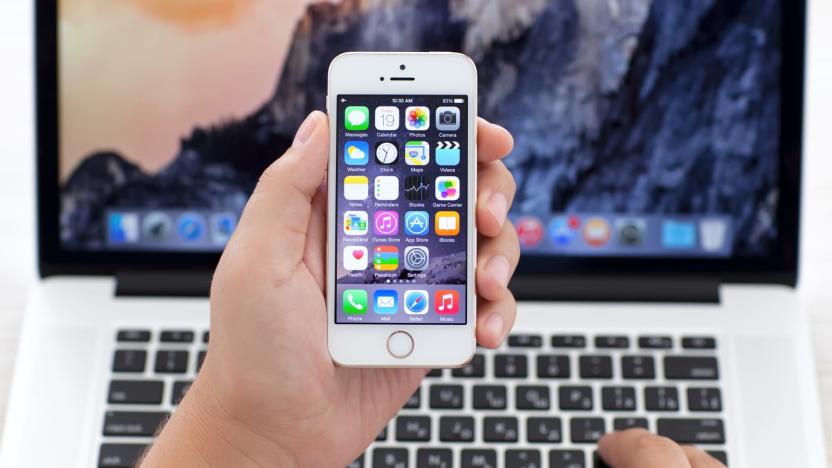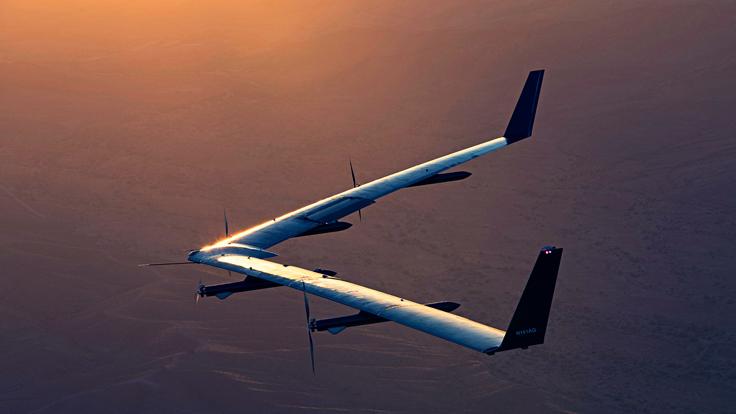Testflight
Latest

Apple's Testflight beta testing service is coming to macOS
Apple announced that its Testflight tool, which allows developers to share their apps with non-developer beta testers, is finally migrating to MacOS.

Microsoft's Project xCloud preview extends to iOS devices
After first launching in preview on Android phones, Microsoft's Project xCloud is making its way over to iOS devices. Starting today, iPhone and iPad owners can check out the game streaming service through Apple's TestFlight platform.

Virgin Orbit's rocket completes its first 'captive carry' flight test
Virgin Orbit just edged closer to its goal of launching rockets in mid-air. The company has completed the first "captive carry" test for its LauncherOne rocket, hauling the 70-foot machine under the wing of Cosmic Girl (its Boeing 747 launch aircraft/Jamiroquai reference) as it flew over southern California. The flight wasn't dramatic, but it provided vital data on how well the two vehicles will behave together when the rocket is ready to fire in earnest.

Rocket Lab reaches orbit for the first time
Rocket Lab has reached orbit for the first time, even though it's only the private space company's second flight. Even more impressive? The test mission, dubbed "Still Testing," had three customer satellites in tow: one is an Earth-imaging satellite, while the other two will track weather and boats. By successfully sending those satellites to orbit, the company has proven that its Electron rocket flights are a viable low-cost alternative for companies that want to send small payloads to space.

Blue Origin tests Crew Capsule 2.0 with 'biggest windows in space'
Jeff Bezos' rocket company isn't quite ready for space tourism, but today's test flight gets it a bit closer. Bezos tweeted that for the first time, Blue Origin has tested version 2.0 of its Crew Capsule, and while he didn't mention how luxurious the test unit is, it does feature "the largest windows in space." Measuring at 2.4 feet wide and 3.6 feet high, they gave the test dummy a great view from 322,405 feet above ground level.

Sierra Nevada spacecraft completes first test flight in 4 years
If Sierra Nevada is going to fulfill supply missions for the International Space Station and the UN, it'll have to prove that its Dream Chaser spacecraft is ready to fly... and it just took a big step in that direction. The company has revealed that Dream Chaser completed a glide test flight on November 11th, launching from a helicopter and landing at California's Edwards Air Force Base. Notably, it's this vehicle's first flight in 4 years, and its first successful landing demonstration -- when this ship last flew in 2013, stuck landing gear forced a rough touchdown.

iOS app developers can now recruit up to 10,000 beta testers
You'll now have a bigger chance of beta testing upcoming iOS, tvOS, watchOS and even iMessage apps from your favorite developers. Cupertino has expanded the number of beta testers devs can invite on TestFlight to a whopping 10,000 from a measly 2,000 people. The tech giant acquired TestFlight's creator in 2014 to give its third-party developer community a simple way to invite testers before releasing their products on the App Store. All they need to send out invitations are email addresses, so they can easily solicit for help online if they're looking for bugs or send previews to members of the press.

Facebook successfully lands its Aquila drone for the first time
Facebook has been testing its solar-powered unmanned aircraft, Aquila, for the past couple of years. The internet-providing drone made its first full flight last June, though it crashed on landing after the 96-minute flight in Yuma, Arizona. The accident prompted a US investigation, which found that the autonomous plane went down due to windy conditions. The second full flight, just announced by Facebook, took place on May 22, ran for one hour and 46 minutes and landed successfully.

Virgin Galactic returns to the skies after two years
Virgin Galactic has announced that it has successfully test-flown its new (edge of) space plane. It's the first time in two years that Galactic craft has taken to the skies as the program was put on hold after the fatal crash in 2014. This flight, which lasted nearly four hours over the Mojave desert, involved the SpaceShipTwo-class launch vehicle, VMS Eve, carry the passenger cruiser, VSS Unity, at heights of over 50,000 feet.

Microsoft's Cortana iPhone app rolls out to beta testers
Less than a month after kicking off the Cortana for iPhone beta signups, Microsoft has started rolling out the app to people who showed interest in testing it. As TechCrunch points out, the early build is being distributed through TestFlight, a developer-focused service that lets iOS users try applications before their public release. Based on the app's current description, Microsoft is asking testers to set a Cortana reminder on a Windows 10 PC and see how it works with an iPhone, as well as communicate with the virtual assistant and observe how she responds to queries. Back in August, Cortana also arrived on Android via public beta, so it's only a matter of time before Microsoft officially releases it on Google and Apple's mobile platforms.

Cheap satellite-launching rocket fails on its maiden flight
Satellite-launching rocket programs like SpaceX, Virgin Galactic and Blue Origin are household names thanks to the larger-than-life personalities behind them. But you may not know about a modest program called Super Strypi. Developed by the University of Hawaii, Sandia National Laboratories and Aerojet Rocketdyne, it aims to use a small, three-stage "sounding rocket," to launch 300 kilogram (660 pound) payloads into low-earth orbit. Now that you're acquainted with it, we have bad news: It failed on its maiden launch in Kauai. The official video (below) shows the rocket apparently losing control, while a spectator video shows the in-flight breakup about 60 seconds after launch.

Jeff Bezos' first proper test rocket has successfully launched
Elon Musk may be the most famous tech billionaire with an interest in spaceflight, but he's certainly not the only one. Amazon founder Jeff Bezos also has a company, Blue Origin, which is doing similar research into reusable craft to get us to-and-from the heavens. The normally secretive outfit has just revealed that its first test vehicle, New Shepard, made arguably its most important, partially successful test flight yesterday. In the experiment, the priapic craft took an (empty) crew capsule to a height of 307,000 feet before releasing it to float gently back to earth.

Relive Orion's deep-space test flight in pictures and videos
On December 5th, NASA's Orion capsule successfully lifted off from its platform at Cape Canaveral in Florida, reaching a max altitude of 3,600 miles in outer space. During the four-and-a-half hour test flight, it entered the Van Allen radiation belt, orbited the planet, survived its fiery re-entry into our atmosphere and dove into the Pacific Ocean to be retrieved by the Navy. Below, you can see images that represent each stage of the spacecraft's flight, from launch to splashdown.

Apple expands TestFlight to include up to 1,000 public beta testers
Apple announced this week that it is expanding its TestFlight Beta testing service, now allowing developers to include public beta testers. According to the new program details, developers can invite up to 1,000 public beta testers via iTunes Connect. You can now invite up to 1,000 testers to beta test your iOS apps by simply sending them an email invitation through iTunes Connect. Once they accept your invitation, testers can install your beta app on their iOS devices, get updated builds, and provide feedback, all within the TestFlight app. Learn more about TestFlight. Apple recently re-launched the TestFlight app that allows beta testers to access beta apps on their iOS device. Developers can easily add testers via an email sent through iTunes Connect. The TestFlight service was acquired by Apple earlier this year.

Apple relaunches iTunes Connect and introduces Test Flight app ahead of Sept 9 event
With the release of iOS 8 coming in the very near future, Apple is prepping developers with a few new tools to help keep their apps working for users and themselves. First up is the relaunch of iTunes Connect's web portal interface. Upon logging in, developers will notice a new flatter design across the board, along with improved graphics and drop down menus. The My Apps section of the site has been updated to provide improved app management, while a Resources and Help option has been added to help with customer issues. If you have a developer account you can see the changes for yourself here. In addition to the new iTunes Connect tools, Apple has finally debuted their TestFlight app for beta testing management. Apple purchased TestFlight's developer Burstly last February. With TestFlight, developers can add users to a beta test using only their email addresses and manage beta users with ease from their mobile devices. The app is available now in the iTunes store as a free download, which you can find here.

The TUAW Daily Update Podcast for February 21, 2014
It's the TUAW Daily Update, your source for Apple news in a convenient audio format. You'll get some the top Apple stories of the day in three to five minutes for a quick review of what's happening in the Apple world. You can listen to today's Apple stories by clicking the player at the top of the page. The Daily Update has been moved to a new podcast host in the past few days. Current listeners should delete the old podcast subscription and subscribe to the new feed in the iTunes Store here.

Apple buys Burstly, owner of TestFlight beta-testing platform
Re/code is confirming the news first reported by TUAW sister site TechCrunch that Apple has purchased Burstly. The company is best known for mobile analytics tool FlightPath, and acquired TestFlight in 2012. Burstly also provides the SkyRocket ad monetization service. iOS beta testers and developers alike are quite familiar with TestFlight, which is used to distribute pre-release versions of apps to limited audiences for beta testing purposes. TechCrunch reported that on Wednesday, TestFlight announced that it would be dropping Android support as of March 21 as well as discontinuing its TestFlight SDK. TechCrunch also noted that FlightPath, which never made it past beta, has also been shut down. Links to FlightPath began being redirected to the TestFlight home page on about February 11. At this point, nobody is quite sure what plans Apple has for Burstly and TestFlight, but we're sure to hear more details as time passes ... perhaps not until the 2014 WorldWide Developer Conference.

Virgin Galactic's SpaceShipTwo completes its second test flight (video)
Virgin Galactic's SpaceShipTwo might not have the flashiest name, but a lack of nominal originality didn't stop it from completing its second test flight today at the Mojave Air and Space Port in California. Back in April, SpaceShipTwo's first flight hit an altitude of 55,000 feet (traveling at Mach 1.2) before descending, but this time around, the little rocket plane that could one-upped itself. After being ferried to a height of approximately 40,000 feet by carrier-craft WhiteKnightTwo, the ship soared to an impressive 69,000 feet at Mach 1.4 while the engine roared for a total of 20 seconds. The outing, led by pilots Mark Stucky and Clint Nichols, also marked the first test of the craft's wing-tilting re-entry system. According to Virgin's Sir Richard Branson, SpaceShipTwo's progress means that the company is still on track to launch its commercial service in 2014. To see the test flight for yourself, check out the video after the break.

SpaceX shows off new nav gear with latest Grasshopper rocket launch-and-landing (video)
We've been watching as the SpaceX Grasshopper's leap has grown higher and higher with each successive launch (and landing!), and the rocket's flights never fail to impress. The reusable spacecraft's latest test is no exception: this time, the 'hopper sailed past its previous 840 feet record, stopping at 1,066 feet. According to the company, the launch had a "more precise" landing thanks to new sensors that measure distance between the ground and the vessel. It shows. The touch-down is both noticeably smoother than previous efforts and drama free compared to Russia's explosive incident in Kazakhstan. The private spaceflight company's latest video is after the break -- do yourself a favor and watch it in HD.

Burstly restructures, now offers three services for code-to-ship functionality
Burstly acquired the beta testing service TestFlight just a few months ago, and TestFlight released a mobile analytics service called FlightPath soon after that. Now, Burstly has announced that it is restructuring its offerings, to set up a full set of services to take developers from developing and testing their app with TestFlight, to preforming analytics with FlightPath, and then monetizing with Burstly's tools, now rebranded as SkyRocket. This is a smart bit of revamping -- TestFlight is very popular, but FlightPath has just started out and SkyRocket's name is brand new to most developers, so combining these tools under the same umbrella should make them all more accessible to developers. All of these services are still available separately, but not only do they share a parent company now, but they also can combine functionality, such as having high profile users from FlightPath get offered different monetization options or deals via SkyRocket. Burstly's wasting no time making its TestFlight acquisition useful. We'll stay tuned to see, going forward, how this trio of services plays with mobile developers.













